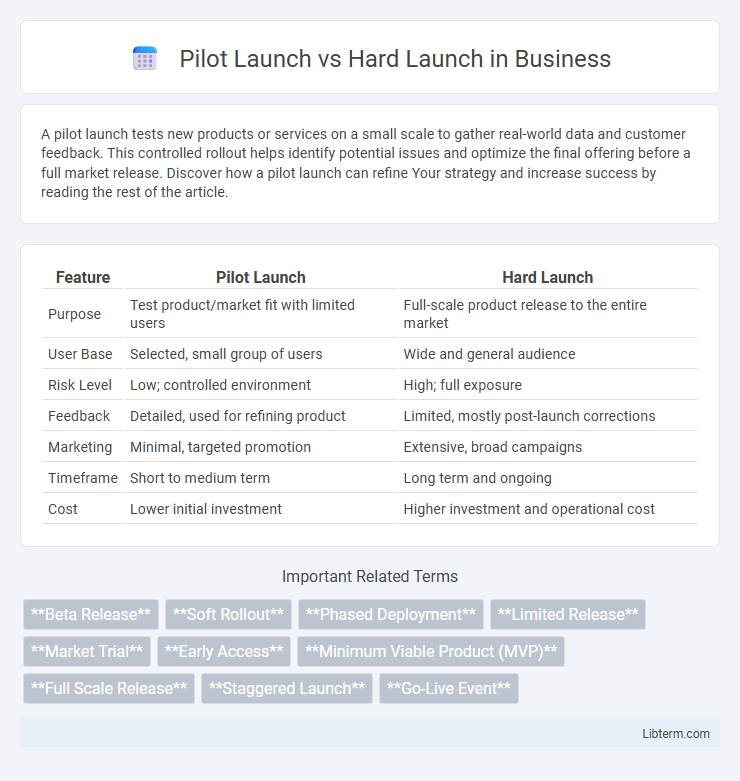A pilot launch tests new products or services on a small scale to gather real-world data and customer feedback. This controlled rollout helps identify potential issues and optimize the final offering before a full market release. Discover how a pilot launch can refine Your strategy and increase success by reading the rest of the article.
Table of Comparison
| Feature | Pilot Launch | Hard Launch |
|---|---|---|
| Purpose | Test product/market fit with limited users | Full-scale product release to the entire market |
| User Base | Selected, small group of users | Wide and general audience |
| Risk Level | Low; controlled environment | High; full exposure |
| Feedback | Detailed, used for refining product | Limited, mostly post-launch corrections |
| Marketing | Minimal, targeted promotion | Extensive, broad campaigns |
| Timeframe | Short to medium term | Long term and ongoing |
| Cost | Lower initial investment | Higher investment and operational cost |
Introduction to Pilot Launch vs Hard Launch
Pilot launch involves releasing a product or service to a limited audience to test performance, gather user feedback, and identify issues before a full-scale introduction. Hard launch, in contrast, signifies the official, broad release of the product to the entire target market without preliminary testing phases. Understanding the differences between pilot launch and hard launch is crucial for effective market entry strategies and minimizing risks associated with product failures.
Defining Pilot Launch: Key Features
A pilot launch is a controlled, small-scale release of a product or service aimed at testing and gathering user feedback before a full-scale rollout. Key features include limited audience targeting, real-time performance monitoring, and iterative improvements based on data collected during the pilot phase. This approach minimizes risks and enhances product-market fit by validating assumptions and identifying potential issues early.
Understanding Hard Launch: Main Characteristics
A hard launch involves fully releasing a product or service to the entire target audience simultaneously, ensuring immediate availability across all channels. This method emphasizes maximum initial impact with comprehensive marketing efforts, strong inventory readiness, and robust technical support to handle high user engagement. Key characteristics include rapid scalability, heightened risk due to lack of phased testing, and the potential for quick feedback collection to drive immediate improvements.
Pros and Cons of Pilot Launch
A pilot launch enables businesses to test a product or service on a smaller scale, reducing the risk of widespread failure by gathering user feedback and identifying potential issues early. This approach can save costs and improve product quality before a full-scale release but may delay time-to-market and limit initial reach and revenue impact. Challenges include managing customer expectations and allocating resources for ongoing adjustments during the pilot phase.
Advantages and Drawbacks of Hard Launch
Hard launch offers a full-scale product release that maximizes initial market impact and accelerates user adoption by making all features immediately available. However, it carries higher risks due to the lack of preliminary user feedback, which can lead to unresolved bugs and potential customer dissatisfaction. The approach demands robust preparation and resources to support rapid issue resolution and maintain service quality.
When to Choose a Pilot Launch
A pilot launch is ideal when testing a product or service with a limited user group to gather real-world feedback and identify potential issues before full-scale deployment. Opt for a pilot launch when market uncertainty exists, allowing for iterative improvements based on user behavior and preferences. This approach minimizes risk and optimizes resources by validating assumptions in controlled settings.
When to Opt for a Hard Launch
Opt for a hard launch when your product is fully developed, well-tested, and all key features are stable to ensure a seamless user experience from day one. Hard launches are ideal for products targeting a wide audience immediately, aiming to maximize market impact and brand visibility. Choose a hard launch when your marketing and support teams are prepared to handle high user traffic and feedback efficiently.
Impact on User Experience and Feedback
Pilot launch allows companies to gather detailed user feedback in a controlled environment, improving product refinement and reducing risks before full-scale deployment. Hard launch delivers the product to the entire market at once, potentially exposing users to unresolved issues and limiting the opportunity for iterative improvements based on early feedback. User experience generally benefits from pilot launches through smoother performance and better alignment with user needs, while hard launches risk negative initial impressions due to a lack of real-world testing.
Case Studies: Successes in Pilot and Hard Launches
The pilot launch of Dropbox allowed the company to gather user feedback and make iterative improvements before scaling, resulting in widespread adoption and a valuation exceeding $10 billion. In contrast, Tesla's hard launch of the Model 3 demonstrated the power of confident mass market entry, generating over 300,000 pre-orders within the first week and solidifying Tesla's position in the electric vehicle industry. Case studies highlight that pilot launches excel in risk mitigation and product refinement, while hard launches drive rapid market penetration and brand momentum.
Choosing the Right Launch Strategy for Your Product
Choosing the right launch strategy between a pilot launch and a hard launch depends on your product's maturity, target market, and risk tolerance. A pilot launch enables real-world testing with a limited audience, yielding valuable insights to refine features and fix issues before full-scale release. A hard launch maximizes immediate impact and market penetration but requires robust readiness and confidence in product stability to avoid potential backlash.
Pilot Launch Infographic

 libterm.com
libterm.com